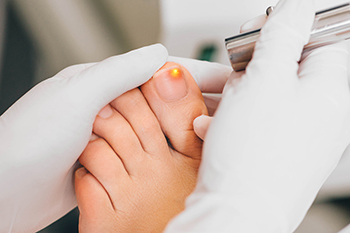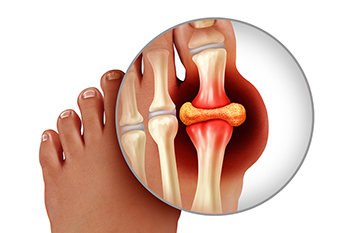Items filtered by date: March 2024
What To Expect During Fungal Toenail Laser Treatment
 Laser treatment is a non-invasive procedure that can be used to target and eliminate toenail fungus. It is a promising alternative to traditional medications or topical treatments. During this procedure, a podiatrist uses a specialized laser to pass light through the toenail without damaging the nail or surrounding skin. The laser specifically targets the fungus, heating and killing the fungal cells to stop them from growing further. Patients can expect the session to last about 30 minutes to an hour, depending on the severity of the infection and the number of toes affected. Most report feeling a warming sensation or slight discomfort during the treatment, but it's generally well-tolerated and doesn't require anesthesia. One of the key benefits of laser therapy is that it has minimal risks of side effects. While some individuals may see improvement after a single session, others might need multiple treatments to get rid of the fungus. Recovery time is minimal, though it may take several months for the nail to grow back out and reveal the full results of the treatment. If you have toenail fungus, it is suggested that you make an appointment with your podiatrist who can determine if laser treatment is appropriate for you.
Laser treatment is a non-invasive procedure that can be used to target and eliminate toenail fungus. It is a promising alternative to traditional medications or topical treatments. During this procedure, a podiatrist uses a specialized laser to pass light through the toenail without damaging the nail or surrounding skin. The laser specifically targets the fungus, heating and killing the fungal cells to stop them from growing further. Patients can expect the session to last about 30 minutes to an hour, depending on the severity of the infection and the number of toes affected. Most report feeling a warming sensation or slight discomfort during the treatment, but it's generally well-tolerated and doesn't require anesthesia. One of the key benefits of laser therapy is that it has minimal risks of side effects. While some individuals may see improvement after a single session, others might need multiple treatments to get rid of the fungus. Recovery time is minimal, though it may take several months for the nail to grow back out and reveal the full results of the treatment. If you have toenail fungus, it is suggested that you make an appointment with your podiatrist who can determine if laser treatment is appropriate for you.
Laser treatment can be an effective way to get rid of toenail fungus. If you have any questions about laser treatment, consult with Amir Shalev, DPM from Complete Foot & Ankle Care. Our doctor will assess your condition and provide you with quality treatment for fungal nails.
What Are Toenail Fungal Infections?
Onychomycosis, or fungal infection of the nail, is a relatively common and non-serious condition. Around 10 percent of U.S. citizens are afflicted with fungal nails. Common forms of fungus that infect the nail include dermatophytes, yeasts, and molds.
Symptoms of Toenail Fungal Infections Include:
- Nail thickening
- Brittleness of the nail
- Discoloration of the nail
Diagnosis for Fungal Nails
Fungal infections are diagnosed by fungal culture and microscopy. This will rule out any other conditions such as nail trauma, psoriasis, lichen planus, and onychogryphosis.
What Is Laser Treatment?
Laser treatment is a non-invasive, safe, quick, and painless procedure that uses the heat from a laser to kill fungus in the nail. Each infected nail is targeted with a laser for several minutes. The treatment is usually utilized several different times over a select period. During this time, a podiatrist will keep an eye on the infection.
If you have any questions, please feel free to contact our office located in Las Vegas, NV . We offer the newest diagnostic and treatment technologies for all your foot care needs.
Arthritis Can Cause Pain in the Feet and Ankles
Various Ways of Testing for Gout

Gout, a painful form of arthritis, often causes intense swelling in a single joint, typically the big toe. Gout is the result of high levels of uric acid in the blood. The uric acid forms crystals in the joints that result in sudden and severe pain, called flare ups. Diagnostic lab tests for gout examine blood or joint fluid for uric acid levels or crystals, though not all cases show elevated uric acid levels. Imaging tests like X-rays, ultrasounds, or special CT scans can help show joint damage or uric acid crystals. Monitoring lab tests can track uric acid levels over time, with additional assessments of kidney function through creatinine and blood urea nitrogen, or BUN, tests. A urinalysis is used to detect uric acid in urine. Regular imaging tests monitor joint health to detect any damage caused by untreated gout. A podiatrist can conduct the appropriate diagnostic tests for gout. If you are experiencing toe joint pain or suspect gout, it is suggested that you schedule an appointment with a podiatrist.
Gout is a painful condition that can be treated. If you are seeking treatment, contact Amir Shalev, DPM from Complete Foot & Ankle Care. Our doctor will treat your foot and ankle needs.
What Is Gout?
Gout is a form of arthritis that is characterized by sudden, severe attacks of pain, redness, and tenderness in the joints. The condition usually affects the joint at the base of the big toe. A gout attack can occur at any random time, such as the middle of the night while you are asleep.
Symptoms
- Intense Joint Pain - Usually around the large joint of your big toe, and it most severe within the first four to twelve hours
- Lingering Discomfort - Joint discomfort may last from a few days to a few weeks
- Inflammation and Redness -Affected joints may become swollen, tender, warm and red
- Limited Range of Motion - May experience a decrease in joint mobility
Risk Factors
- Genetics - If family members have gout, you’re more likely to have it
- Medications - Diuretic medications can raise uric acid levels
- Gender/Age - Gout is more common in men until the age of 60. It is believed that estrogen protects women until that point
- Diet - Eating red meat and shellfish increases your risk
- Alcohol - Having more than two alcoholic drinks per day increases your risk
- Obesity - Obese people are at a higher risk for gout
Prior to visiting your podiatrist to receive treatment for gout, there are a few things you should do beforehand. If you have gout you should write down your symptoms--including when they started and how often you experience them, important medical information you may have, and any questions you may have. Writing down these three things will help your podiatrist in assessing your specific situation so that he or she may provide the best route of treatment for you.
If you have any questions, please feel free to contact our office located in Las Vegas, NV . We offer the newest diagnostic and treatment technologies for all your foot care needs.
What to Look for in Walking Shoes

When searching for the ideal walking shoes, prioritize comfort and fit above all else. Ensure that your shoes provide adequate support while accommodating the unique shape of your feet. Before shopping for walking shoes, it may be wise to visit a podiatrist for a gait analysis and to see if any foot abnormalities may indicate the need for custom-made orthotics. Look for shoes with cushioning and stability, but don't assume that more cushioning is always better. Instead, opt for a balance that promotes natural foot movement. Try on shoes later in the day when your feet are at their largest. Bring along socks of the thickness you typically wear, and test the shoes by taking a few laps around the store to assess comfort and fit. Ensure there's enough space for your toes to wiggle and that there's at least a finger's width of space between your longest toe and the front of the shoe. For help with foot problems associated with walking, it is suggested that you make an appointment with a podiatrist.
It is important to find shoes that fit you properly in order to avoid a variety of different foot problems. For more information about treatment, contact Amir Shalev, DPM from Complete Foot & Ankle Care. Our doctor will treat your foot and ankle needs.
Proper Shoe Fitting
Shoes have many different functions. They cushion our body weight, protect our feet, and allow us to safely play sports. You should always make sure that the shoes you wear fit you properly in order to avoid injuries and deformities such as: bunions, corns, calluses, hammertoes, plantar fasciitis, stress fractures, and more. It is important to note that although a certain pair of shoes might be a great fit for someone else, that doesn’t mean they will be a great fit for you. This is why you should always try on shoes before buying them to make sure they are worth the investment. Typically, shoes need to be replaced ever six months to one year of regular use.
Tips for Proper Shoe Fitting
- Select a shoe that is shaped like your foot
- Don’t buy shoes that fit too tight, expecting them to stretch to fit
- Make sure there is enough space (3/8” to ½”) for your longest toe at the end of each shoe when you are standing up
- Walk in the shoes to make sure they fit and feel right
- Don’t select shoes by the size marked inside the shoe, but by how the shoe fits your foot
The shoes you buy should always feel as good as they look. Shoes that fit properly will last longer, feel better, and improve your way of life each day.
If you have any questions, please feel free to contact our office located in Las Vegas, NV . We offer the newest diagnostic and treatment technologies for all your foot care needs.
Back of the Ankle Pain Experienced by Dancers

Pain at the back of a dancer’s ankle can happen for various reasons, ranging from overuse to specific injuries. Achilles tendonitis, a common condition among dancers, results from repetitive stress on the Achilles tendon, leading to inflammation and discomfort. Another possible cause is posterior impingement syndrome, often seen in dancers who frequently point their toes, causing compression and irritation at the back of the ankle joint. Additionally, Haglund's deformity, characterized by a bony prominence at the back of the heel, can exacerbate discomfort, especially when wearing tight-fitting shoes. If you are a dancer and are experiencing ankle pain, it is suggested that you schedule an appointment with a podiatrist for an accurate diagnosis and effective treatment.
Ankle pain can be caused by a number of problems and may be potentially serious. If you have ankle pain, consult with Amir Shalev, DPM from Complete Foot & Ankle Care. Our doctor will assess your condition and provide you with quality foot and ankle treatment.
Ankle pain is any condition that causes pain in the ankle. Due to the fact that the ankle consists of tendons, muscles, bones, and ligaments, ankle pain can come from a number of different conditions.
Causes
The most common causes of ankle pain include:
- Types of arthritis (rheumatoid, osteoarthritis, and gout)
- Ankle sprains
- Broken ankles
- Achilles tendinitis
- Achilles tendon rupture
- Stress fractures
- Bursitis
- Tarsal tunnel syndrome
- Plantar fasciitis
Symptoms
Symptoms of ankle injury vary based upon the condition. Pain may include general pain and discomfort, swelling, aching, redness, bruising, burning or stabbing sensations, and/or loss of sensation.
Diagnosis
Due to the wide variety of potential causes of ankle pain, podiatrists will utilize a number of different methods to properly diagnose ankle pain. This can include asking for personal and family medical histories and of any recent injuries. Further diagnosis may include sensation tests, a physical examination, and potentially x-rays or other imaging tests.
Treatment
Just as the range of causes varies widely, so do treatments. Some more common treatments are rest, ice packs, keeping pressure off the foot, orthotics and braces, medication for inflammation and pain, and surgery.
If you have any questions, please feel free to contact our office located in Las Vegas, NV . We offer the newest diagnostic and treatment technologies for all your foot care needs.

